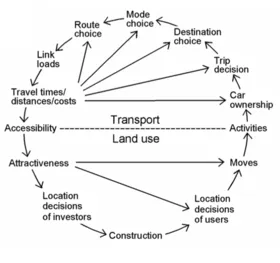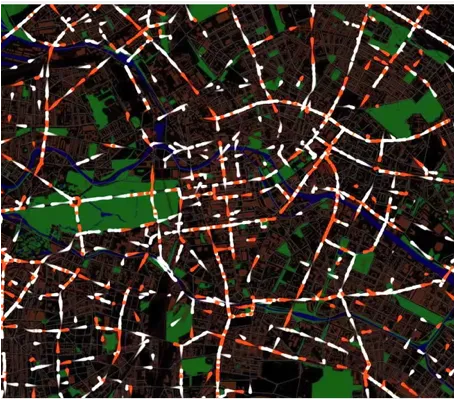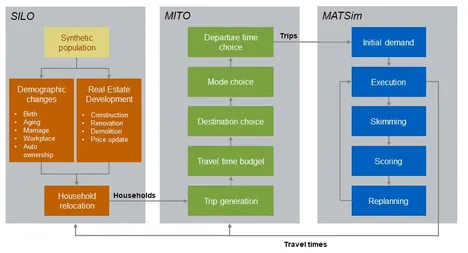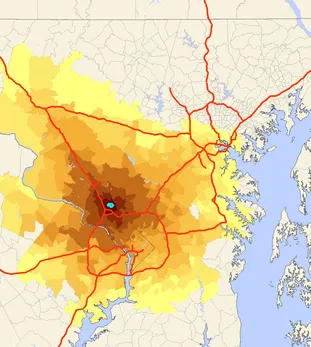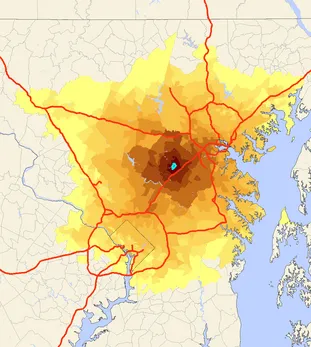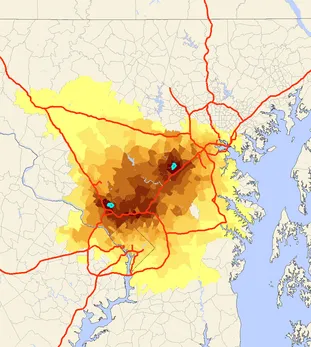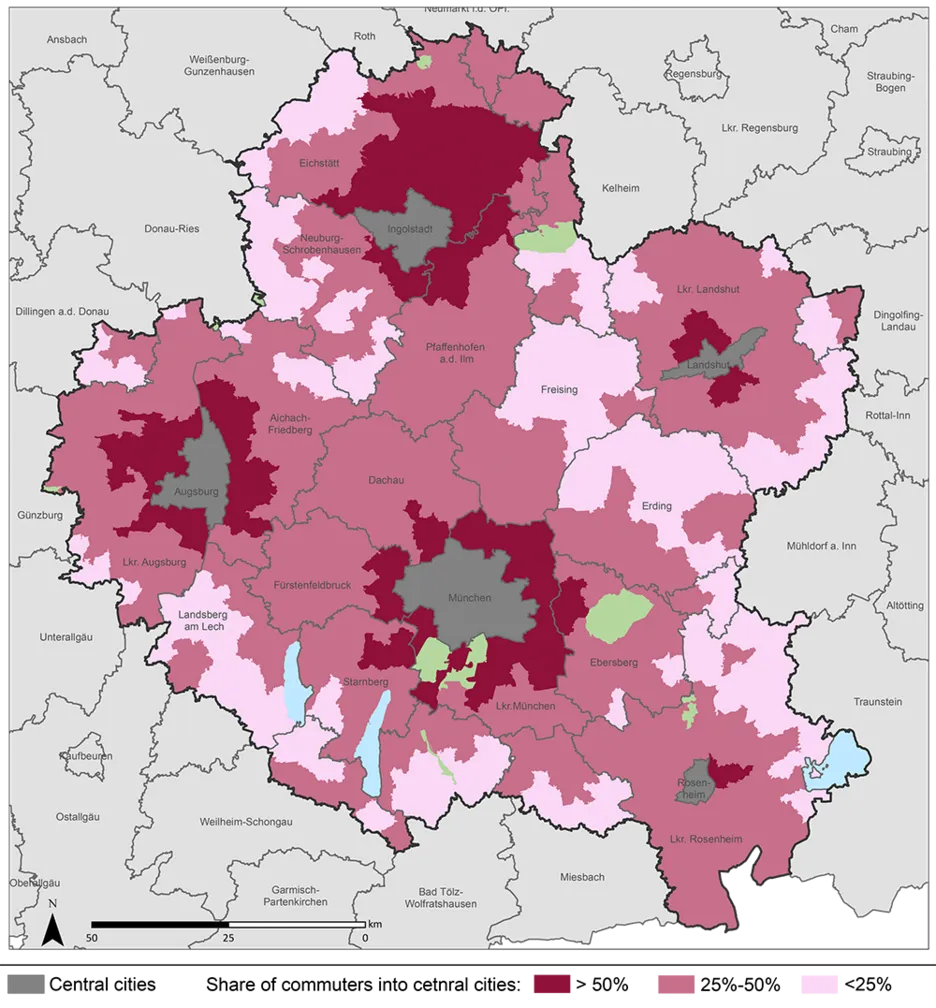Integration of land use and transport
This group has worked actively in the integration of different models, in particular land use models with transport models.
An integrated land use/transportation model is developed by linking the land use model SILO, the travel demand model MITO and the transport model MATSim.In contrast to traditional models, feedback between land use and transport is provided at the micro level
Land use/transport interactions
Land use and transport are closely connected. The transport system (shown on the top of Figure 1) provides travel times under current congestion, which are used in land use models (bottom half of Figure 1) to assess the desirability of locations. Based on where people live and work, demand for travel is derived. This leads to updated congestion, and hence, new travel times. This feedback cycle is modelled using the microscopic models SILO (Land use), MITO (Travel Demand) and MATSim (Traffic assignment).
SILO
In SILO, the demography of households is modeled on a year to year basis from 2000 to 2050. A household relocation module simulates housing search with a series of logit models. A developer model simulates investment decisions of developers who build new residential floorspace when demand is high. Housing renovation, deterioration, demolition and price adjustments are modeled as well by the developer model. At the beginning of every simulation period, events are created that are executed in random order. Somewhere, a child is born, someone else celebrates her birthday, elsewhere a new dwelling is built, some people get married, etc. By executing events in random order, artificial path dependency is avoided and events may affect each other as they do in real life. For example, the birth of a child often triggers a move to a larger apartment or a single-family home.
Demographic changes modeled in SILO
| Household | |
| Relocation | Buy or sell cars |
| Person | |
| Aging | Divorce |
| Leave parental household | Death |
| Marriage | Find a new job |
| Birth to a child | Quit a job |
| Dwelling | |
| Construction of new dwellings | Demolition |
| Renovation | Adjust housing price |
| Deterioration |
Further information on SILO can be found here: www.silo.zone.
MITO
MITO (Microscopic Transport Orchestrator) is the model that generates the travel demand of the synthetic population represented in SILO. MITO is a microscopic model that generates lists of individual trips, assign them to persons and distribute them among destinations. A transportation mode and a time of departure is also assigned to each trip.
MATSim
MATSim is a framework for large-scale agent-based transport simulations. The basic principles are similar as in SILO except that they operate on a much shorter time scale: Travelers are modeled individually throughout a typical day. Each traveler at some point in time leaves her/his first activity location, follows a trip to its second activity location, performs that activity, etc., until eventually the day is over. In contrast to SILO, MATSim assumes (noisy) equilibrium conditions, which are approached by repeating the simulation of this typical day over and over again, while the synthetic travelers try out various travel options until they eventually settle at the one that returns the highest benefit. In other words, a typical MATSim run iterates and the synthetic travelers evaluate and memorize past synthetic experiences, come up with new travel options, or choose between memorized new travel options. Further information on MATSim can be found here: www.matsim.org/.
Microscopic Model Integration
Traditionally, land-use and transportation models are coupled by using accessibilities. As SILO, MITO and MATSim work microscopically, this model setup allows considering actual travel times experienced by individual people. For example, a worker who leaves for work at 10 AM will see a different level of congestion than a worker who needs to report to work by 8 AM. Regular teleworkers may disregard travel time to work entirely. Another worker who commutes by bus will only consider transit travel times while auto travel times are mostly irrelevant.
Travel time to work is an actual constraint in housing location choice. The individually experienced travel time can be considered in household relocation in SILO. This microscopic linkage between SILO, MITO and MATSim is expected to better represent actual constraints households face in housing search.
Constant Travel Budgets
Initially proposed by Zahavi (1980), and since then confirmed empirically many times, travel budgets are constant. At the aggregate level across an entire population, average travel budgets do not change over time. Therefore, observed trip length frequency distributions are used as an actual constraint that is matched when modeling household relocation.
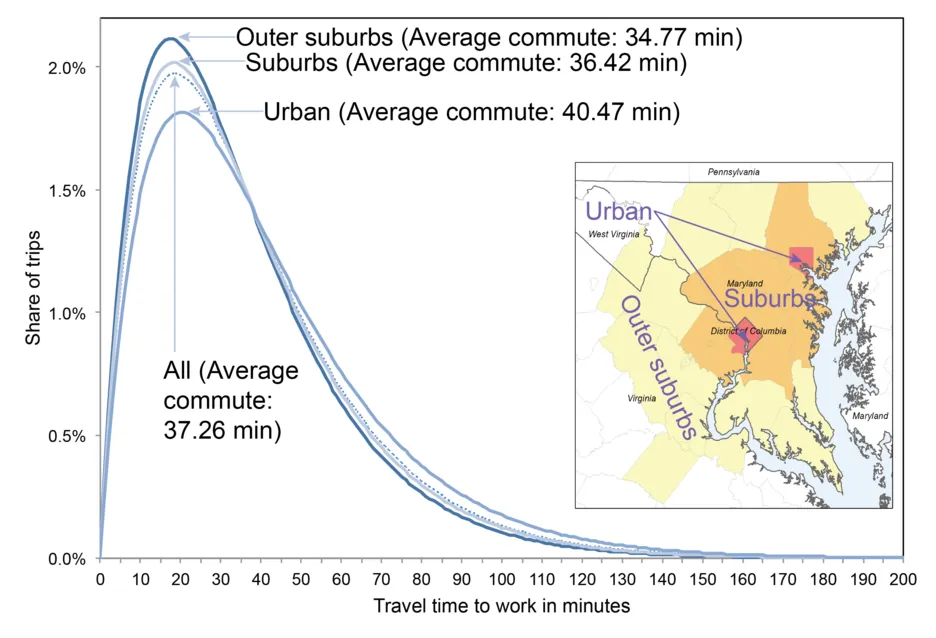
Representation of Constraints
When households look for a new housing location, the job locations of all household members are taken into account. As SILO is designed as a microsimulation, the work locations of all household members are known. The left map in Figure 4 shows an example of a work location in North Bethesda, MD (turquoise dot). The trip length frequency distribution in minutes is used to estimate the utility in terms of commute distance for every zone (shown in brown-to-yellow colors).
The map in the center shows the home location probability for a person working in Columbia, MD. If these two persons lived in the same household, their joint area within a reasonable distance to their work locations is shown in the map on the right side of Figure 4. SILO explicitly represents this constraint when searching for a new housing location.
